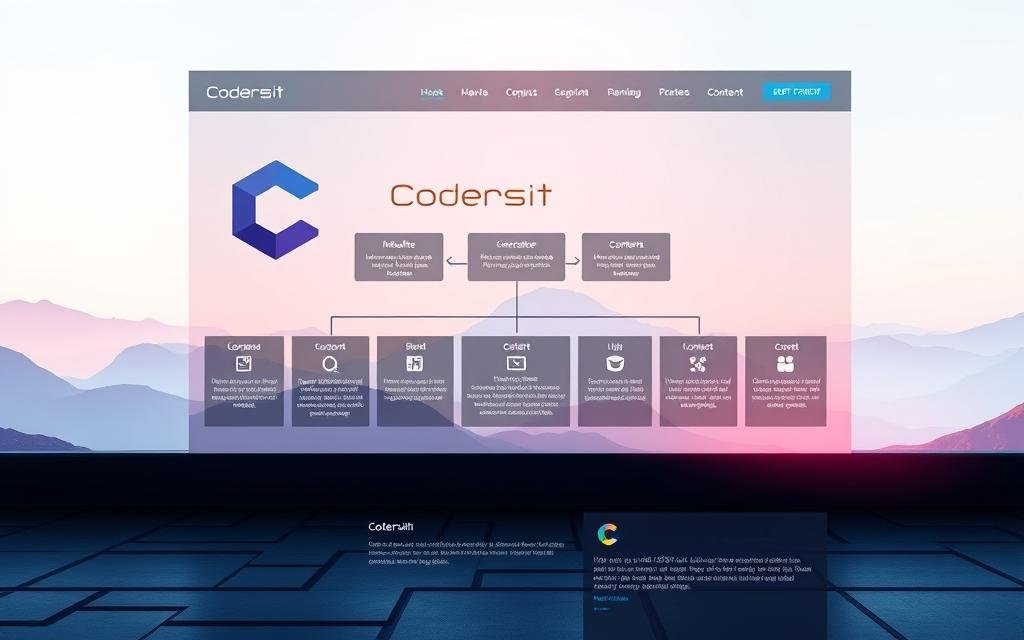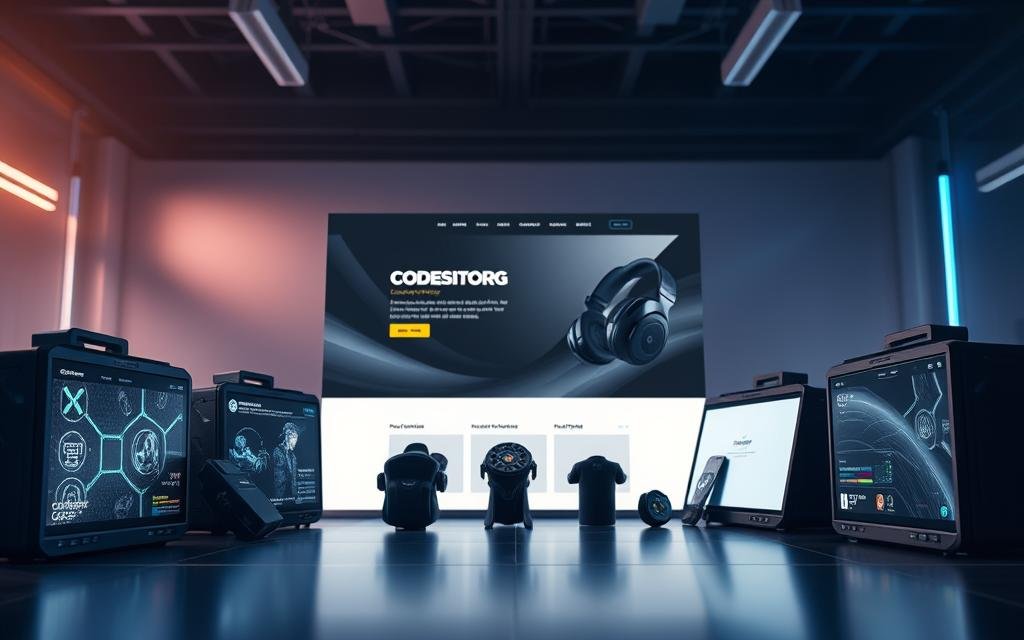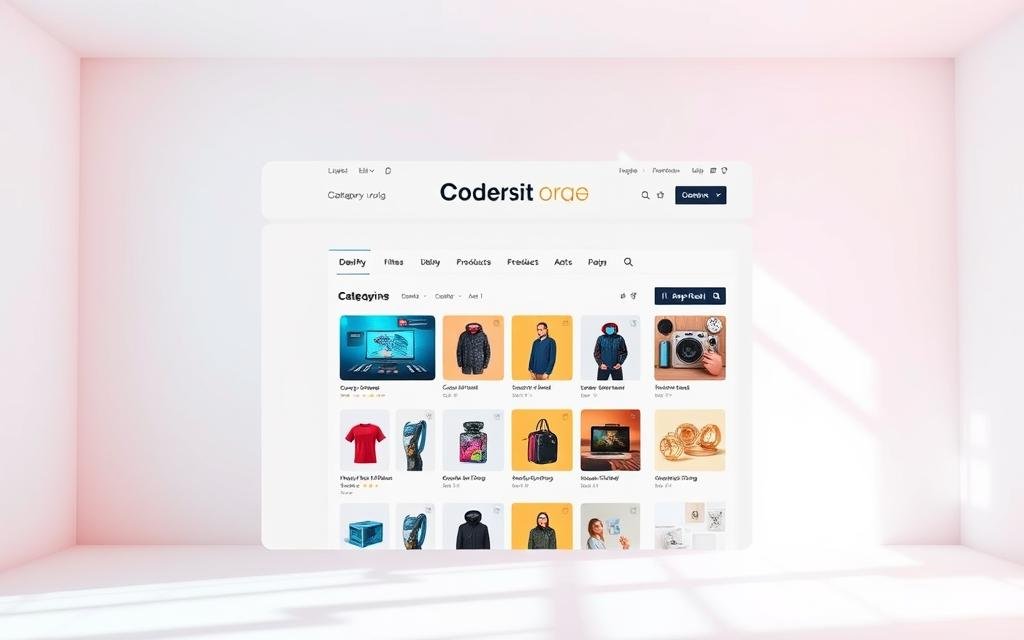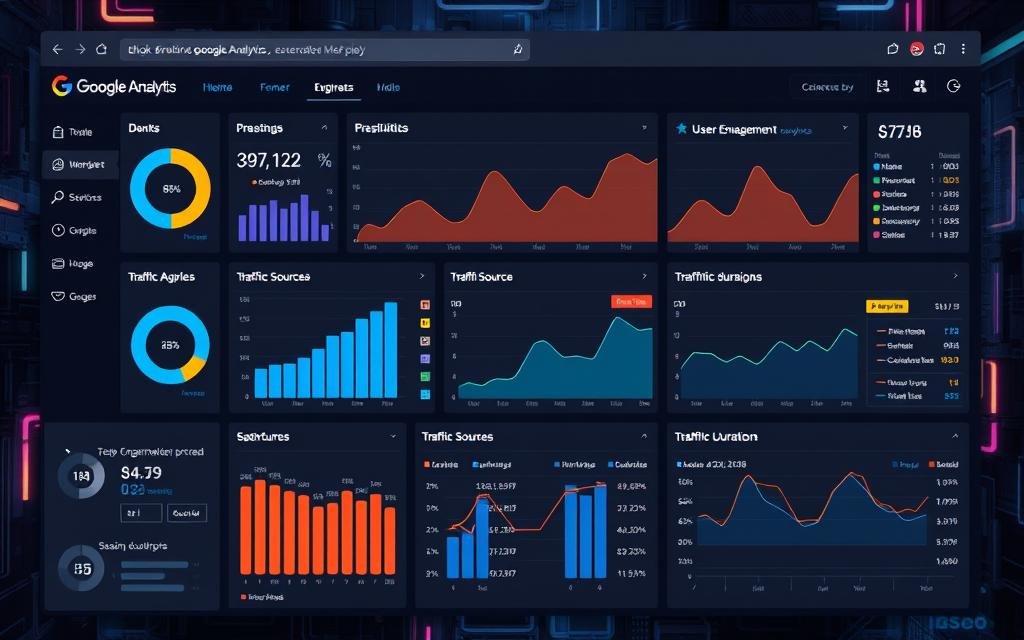In today’s competitive digital marketplace, having an online store that is visible to potential customers is crucial for success.
With millions of ecommerce websites competing for attention, search engines have become the primary gateway for consumers seeking products and services.
To stand out and drive organic traffic to your website, implementing effective SEO strategies is essential.
By optimizing your online store for search engines, you can increase your visibility, reach the right customers at the right time, and achieve sustainable growth without relying solely on paid advertising.
Key Takeaways
- Effective ecommerce SEO strategies can increase online store visibility.
- Proper SEO helps online stores stand out among millions of competitors.
- Optimizing product and category pages drives more organic traffic.
- Ecommerce businesses can achieve sustainable growth through SEO.
- SEO is crucial for ecommerce success in today’s digital marketplace.
The Growing Importance of E-Commerce SEO
With millions of online stores competing for attention, e-commerce SEO is the key to standing out in a crowded digital landscape. The online retail space has become increasingly competitive, with new businesses emerging daily and existing ones expanding their digital footprint.
The Competitive Landscape of Online Retail
The competitive landscape of online retail is characterized by a vast number of players, ranging from small, niche stores to large, multinational corporations. Effective SEO is crucial for businesses to differentiate themselves and attract potential customers. Key aspects of this competitive landscape include:
- Increasing competition from new entrants
- Expanding product offerings from established brands
- Growing consumer expectations for seamless online shopping experiences

How SEO Drives Sustainable Traffic and Sales
SEO helps online stores get found by the right customers at the right time. Unlike paid advertising, which stops generating traffic when you stop paying, strong SEO creates a sustainable foundation for long-term visibility and sales. Some key benefits of SEO for e-commerce businesses include:
- Connecting products with customers who are actively searching for them
- Building credibility and trust with both search engines and potential customers
- Reducing customer acquisition costs by decreasing reliance on paid advertising
- Driving qualified traffic with higher intent to purchase
By implementing a comprehensive SEO strategy, e-commerce businesses can create a virtuous cycle where improved rankings lead to more traffic, resulting in more sales and customer data that can further refine their approach.
Understanding E-Commerce SEO Fundamentals
The foundation of a successful e-commerce SEO strategy lies in understanding its core principles. E-commerce SEO differs significantly from traditional SEO due to the unique nature of online stores, which include numerous product pages, complex site structures, and a focus on conversion-driven optimization.
What Makes E-Commerce SEO Different
E-commerce SEO is distinct from other forms of SEO because it involves optimizing a large number of product and category pages. Effective e-commerce SEO requires a deep understanding of how search engines crawl, index, and rank product pages, as well as how users interact with these pages.
Unlike informational websites, e-commerce sites need to balance SEO with user experience and conversion optimization. This means that e-commerce SEO strategies must be highly nuanced, taking into account factors like product variations, faceted navigation, and user intent.

Key Metrics That Matter for Online Stores
To measure the success of e-commerce SEO efforts, online stores must track a range of key metrics. These include:
- Conversion rates from organic search, which indicate the effectiveness of SEO in driving sales.
- Revenue per visit from organic search, providing insight into the quality of traffic generated by SEO efforts.
- Average order value from organic search visitors, helping to determine if the SEO strategy is attracting high-value customers.
- Organic search visibility for product and category pages, indicating how well core commercial pages are performing.
By focusing on these key metrics and understanding what makes e-commerce SEO different, online stores can develop effective SEO strategies that drive traffic, conversions, and revenue.
Comprehensive Keyword Research for Online Stores
Keyword research stands as a foundational element in optimizing e-commerce sites for search engines. It involves identifying the terms and phrases your target audience uses to search for products like yours.
Finding Product-Focused Keywords
To start, you need to identify product-focused keywords that directly relate to your offerings. Tools like Semrush or Ahrefs can be invaluable in this process, helping you uncover relevant keywords and phrases.
For instance, when researching keywords for an e-commerce site selling outdoor gear, you might use tools to find popular search terms related to camping equipment or hiking accessories.
Analyzing Commercial Intent
Not all keywords are created equal; some have more commercial intent than others. Analyzing the commercial intent behind keywords helps you prioritize those that are more likely to convert.
For example, a keyword like “best hiking backpacks” indicates a high level of commercial intent, as the searcher is likely looking to make a purchase.
Competitor Keyword Analysis
Understanding what keywords your competitors are ranking for can provide valuable insights into your own SEO strategy. By analyzing competitor keywords, you can identify gaps in your strategy and uncover new opportunities.
- Analyzing competitor keywords reveals gaps in your own strategy and uncovers valuable terms you might have overlooked.
- Use tools like Semrush or Ahrefs to identify which keywords your competitors rank for that you don’t, prioritizing those with high search volume and commercial intent.
- Examine the top-performing product and category pages of your competitors to understand which keywords drive their organic traffic.
- Look beyond direct competitors to industry-leading e-commerce sites like Amazon to discover category structure and keyword hierarchies that work.
- Pay special attention to competitors’ featured snippets and rich results, as these indicate effective keyword targeting and structured data implementation.
- Identify competitors’ keyword gaps by finding terms they don’t rank for but align with your products, representing potential opportunities.
- Create a competitive advantage by targeting long-tail variations of keywords your competitors rank for, especially those with high conversion potential.
By now, you should have a solid list of product-focused keywords gathered from Amazon’s suggestions and competitor research, category-based keywords pulled from Amazon’s categories and your competitors’ top-performing pages, and long-tail keywords that target specific, less competitive terms your customers search for.
Building an SEO-Friendly Site Architecture
Building a scalable site architecture is key to enhancing your ecommerce site’s SEO. A well-planned architecture not only improves user experience but also facilitates search engine crawling and indexing.
To achieve this, two golden rules are essential: Keep things simple and scalable, and ensure every page is three or fewer clicks from your homepage. Following these principles helps in creating a site structure that is both user-friendly and SEO-optimized.
The “Three-Click Rule” for E-Commerce Navigation
The “Three-Click Rule” is a guideline that suggests users should be able to find any page on your site within three clicks. This improves site navigation and enhances user experience, contributing to better SEO performance.
Implementing this rule requires a logical category structure that allows users to easily navigate from broad categories to specific subcategories. This hierarchy mirrors how customers naturally narrow their product search, improving the overall user experience.
Creating Scalable Category Structures
A scalable category structure anticipates future growth, enabling the addition of new products and categories without disrupting the existing site architecture. To achieve this, it’s crucial to design a logical hierarchy that moves from broad to specific categories.
- Implement a logical hierarchy that mirrors customer search behavior.
- Avoid too many top-level categories to prevent overwhelming users and diluting SEO value.
- Design category names based on keyword research to align with customer searches.
- Balance SEO considerations with usability for an intuitive category structure.
- Consider faceted navigation for large product catalogs, ensuring proper technical SEO to avoid duplicate URLs.
- Create a consistent URL structure that reflects the category hierarchy, aiding user and search engine understanding.

By following these guidelines and creating a scalable and user-friendly site architecture, ecommerce businesses can improve their SEO performance, driving more traffic and sales.
Technical SEO Essentials for E-Commerce Websites
For e-commerce businesses, technical SEO is a key factor in enhancing their online presence. It encompasses various elements that work together to improve a website’s visibility, crawlability, and overall performance on search engines.
Site Speed Optimization Techniques
Site speed is a critical factor in technical SEO, as it directly impacts user experience and search engine rankings. To optimize site speed, e-commerce businesses can leverage various tools such as Google PageSpeed Insights, GTmetrix, and Pingdom. These tools help identify areas of improvement, including image compression, code minification, and browser caching.

Some of the key site speed optimization techniques include optimizing images, minifying CSS and JavaScript files, and leveraging browser caching. By implementing these techniques, e-commerce sites can significantly improve their loading times, leading to better user engagement and higher conversion rates.
Mobile Optimization Strategies
With the majority of online shoppers using mobile devices, mobile optimization is no longer optional. E-commerce sites must ensure that their websites are responsive, fast, and provide a seamless user experience across various devices. This includes optimizing product pages, simplifying navigation, and ensuring that checkout processes are mobile-friendly.
Mobile optimization is not just about aesthetics; it’s also about functionality and performance. Search engines prioritize mobile-friendly websites, making it essential for e-commerce businesses to adopt mobile-first design principles.
Handling SSL and Security Concerns
Having an SSL certificate is no longer a choice but a necessity for e-commerce sites. Google has explicitly stated that having an SSL connection can give your site a ranking boost. Moreover, it ensures that customer data is transmitted securely, building trust with both users and search engines.
Key Security Measures:
- SSL certificates are mandatory for e-commerce sites, not only for security but also as a ranking factor that Google explicitly recognizes.
- Implement HTTPS across your entire site, not just checkout pages, to build trust with both users and search engines.
- Address mixed content warnings that occur when secure pages load insecure elements, as these undermine security and user confidence.
- Regularly update your e-commerce platform, plugins, and extensions to patch security vulnerabilities that could compromise customer data.
- Display trust badges and security certifications prominently to reassure shoppers that their personal and payment information is protected.
- Implement proper PCI DSS compliance measures to ensure secure handling of credit card information.
- Consider additional security measures like two-factor authentication for admin access and regular security audits to identify potential vulnerabilities.
- Use security headers like Content-Security-Policy and X-XSS-Protection to provide additional layers of protection against common web attacks.
Mastering URL Structure and Canonicalization
A well-planned URL structure and canonicalization strategy can significantly boost your e-commerce site’s search engine rankings. Effective management of these elements is crucial for ensuring that search engines can crawl and index your site’s pages correctly.

Creating SEO-Friendly URLs for Products
Creating SEO-friendly URLs for products is essential for improving visibility in search engine results. URLs should be descriptive, concise, and include target keywords. For instance, instead of using a URL like “example.com/product123,” use “example.com/product-name.” This not only helps search engines understand the content of the page but also improves user experience.
According to SEO expert, “Rand Fishkin”,
“A good URL structure can make a significant difference in how search engines rank your pages.”
It’s also important to avoid using session IDs or other parameters that can create multiple versions of the same URL.
Managing Duplicate Content Issues
Duplicate content is a common issue in e-commerce sites, often arising from product variations, faceted navigation, and manufacturer-provided descriptions. To manage this, use canonical tags to indicate the preferred version of a page. For example, if you have multiple URLs showing similar content, canonical tags help search engines consolidate ranking signals to the main product page.
- Implement canonical tags to specify the original version of a product page.
- Address product variations by consolidating them onto a single page or using canonical tags.
- Manage faceted navigation to prevent indexing of filter combinations that create duplicate content.
- Write unique product descriptions to avoid using manufacturer-provided text that may appear on other websites.
By mastering URL structure and canonicalization, e-commerce sites can improve their SEO, reduce duplicate content issues, and enhance overall search engine rankings.
On-Page SEO for Product Pages
On-page SEO for product pages is a critical component of e-commerce marketing. It involves optimizing individual product pages to rank higher in search engine results, thereby increasing visibility and driving more sales. Effective on-page SEO strategies can make a significant difference in the performance of an online store.
Crafting Compelling Title Tags with Modifiers
Crafting compelling title tags is essential for product page SEO. Title tags should include relevant keywords and modifiers to attract searchers and improve click-through rates. For instance, using modifiers like “buy,” “discount,” or “review” can enhance the title’s appeal. A well-structured title tag should be descriptive, concise, and enticing.
For example, a title tag like “Buy Women’s Cotton Summer Dresses Online | Discounted Prices” includes the primary keyword “women’s cotton summer dresses” and modifiers like “buy” and “discounted prices.” This approach helps in capturing both the search intent and the attention of potential customers.
Writing Unique Product Descriptions
Unique and compelling product descriptions are vital for both user experience and SEO. Instead of using manufacturer-provided descriptions, online stores should create original content that highlights the product’s features, benefits, and unique selling points. This not only helps in avoiding duplicate content issues but also provides value to the customers.
When writing product descriptions, focus on the product’s key attributes and how they address the customer’s needs. Incorporate relevant keywords naturally to improve the page’s SEO without compromising readability.
Optimizing Product Images for Search
Optimizing product images is another crucial aspect of on-page SEO for product pages. High-quality product images are essential for showcasing products in detail and enhancing user experience. To optimize images, use descriptive file names that include target keywords, such as “women-cotton-summer-dress.jpg.”
- Use descriptive, keyword-rich file names for product images.
- Write detailed alt text that incorporates relevant keywords naturally.
- Compress images to reduce file size without sacrificing quality.
By implementing these strategies, online stores can improve their product page visibility, drive more traffic, and ultimately increase sales. 
Additionally, using multiple images from different angles and including lifestyle images can enhance the user experience and improve conversion rates. Don’t forget to add structured data markup to product images to enable rich results in Google Image search.
Category Page Optimization Strategies
To boost their online presence, e-commerce businesses must focus on optimizing their category pages effectively. Category pages serve as a crucial navigational aid and content hub, making their optimization vital for both user experience and search engine rankings.

Balancing Category Content and User Experience
Striking the right balance between content and user experience on category pages is essential. High-quality content that is both informative and engaging can significantly enhance the user experience. This includes providing detailed category descriptions, using relevant images, and ensuring that the page is easily navigable.
Adding great product images to category pages and linking to them from other relevant pages on the website can improve both user engagement and internal linking. Implementing an ‘Other customers also look at’ feature not only helps customers find related products more quickly but also enhances internal linking by creating pathways to other relevant products.
Internal Linking Between Categories and Products
Effective internal linking is crucial for distributing link equity throughout the site, helping important product and category pages rank higher in search results. Creating logical pathways between related categories, subcategories, and products mirrors how customers naturally shop and browse, enhancing their overall experience.
- Implement “related products” and “customers also bought” sections to provide valuable cross-linking opportunities.
- Use descriptive, keyword-rich anchor text for internal links to improve SEO.
- Link from high-authority pages to key category pages to boost their ranking potential.
- Create contextual links within category descriptions that point to relevant subcategories or featured products.
By implementing these strategies, e-commerce businesses can improve both the user experience and search engine rankings of their category pages, ultimately driving more sales and enhancing their online presence.
Implementing Structured Data for Rich Results
Rich results are a game-changer for online stores, and structured data is the key to achieving them. By implementing structured data, e-commerce businesses can significantly improve their search engine rankings and drive more traffic to their sites.
Structured data helps search engines like Google understand the content and context of your website, enabling them to display your pages in a more informative and appealing way in search results.
Product Schema Markup Essentials
To get started with structured data, it’s essential to understand product schema markup. This involves adding specific code to your product pages to provide search engines with detailed information about your products, such as price, availability, and reviews.
Using a structured data testing tool, you can verify that your schema markup is correct and make any necessary adjustments.
Business Information Schema for Trust Signals
In addition to product schema, you can also use structured data to provide business information. Google uses this data to verify the accuracy of the information on your site and in your Google Business Profile.
To establish trust with both search engines and potential customers, implement Organization and LocalBusiness schema types to communicate essential information like business name, address, phone number, and operating hours.
- Consistent business information across your website, Google Business Profile, and other online directories strengthens local SEO and builds credibility.
- Include additional trust signals through structured data such as your business founding date, social media profiles, and corporate contacts.
- For businesses with physical locations, proper LocalBusiness schema can help your store appear in local pack results and on Google Maps.
By implementing structured data for business information, you can help Google understand your brand identity and potentially contribute to knowledge panel displays for your company.
Content Marketing for E-Commerce SEO
Content marketing is the backbone of a successful e-commerce SEO strategy. By creating high-quality, relevant content, e-commerce businesses can demonstrate their expertise and passion for their products, building trust with both Google and potential customers.

Creating a Strategic Blog for Your Online Store
Developing a strategic blog is essential for e-commerce businesses looking to enhance their SEO. By publishing regular, well-researched articles, you can target a wider range of keywords and attract potential customers at various stages of their buying journey. A strategic blog also allows you to showcase your product expertise and build brand authority.
To maximize the SEO benefits of your blog, focus on creating comprehensive, authoritative content that addresses the needs and concerns of your target audience. This can include product reviews, industry insights, and how-to guides that provide value to your customers.
Developing Buyer Guides and Educational Content
Buyer guides and educational content play a crucial role in bridging the gap between informational searches and product purchases. By creating comprehensive buying guides, you can help customers understand product features, benefits, and selection criteria, naturally incorporating relevant keywords and enhancing your SEO.
- Create detailed guides that objectively evaluate different products or brands, positioning your store as a trustworthy advisor.
- Develop educational content that demonstrates expertise and builds credibility with both search engines and potential customers.
- Address common customer questions and pain points with detailed how-to content that showcases your products in action.
By structuring your educational content with clear headings, bullet points, and visual elements, you can improve readability and user engagement. Including relevant statistics, research, and expert insights can further enhance the authority of your content, supporting E-A-T signals and improving your SEO performance.
User Experience and Conversion Optimization
A seamless user experience is key to maximizing conversions in e-commerce. With the ever-increasing competition in online retail, businesses must prioritize both user experience and conversion optimization to stay ahead. This involves not only making the site visually appealing but also ensuring that it is functional, fast, and easy to navigate.
Site Search Functionality Improvements
Improving site search functionality is crucial for enhancing user experience. When users can easily find what they’re looking for, they’re more likely to make a purchase. To achieve this, e-commerce sites should implement advanced search features such as autocomplete, filters, and synonyms recognition. Effective search functionality can significantly reduce bounce rates and increase conversion rates.
Moreover, analyzing search data can provide valuable insights into user behavior and preferences, helping businesses to refine their product offerings and marketing strategies.
Optimizing for Core Web Vitals
Core Web Vitals are a set of specific metrics that Google uses to evaluate page experience, directly impacting both search rankings and user engagement. To optimize for Core Web Vitals, focus on improving Largest Contentful Paint (LCP), First Input Delay (FID), and Cumulative Layout Shift (CLS).
- Improve LCP by prioritizing the loading of above-the-fold content and main product images.
- Enhance FID by minimizing JavaScript execution time and breaking up long tasks that block the main thread.
- Address CLS by specifying image dimensions, reserving space for ads and dynamic content, and avoiding inserting content above existing content.
Tools like Google PageSpeed Insights and the Core Web Vitals report in Google Search Console can help identify specific issues affecting your site’s performance. Implementing critical CSS and deferring non-critical styles can also improve initial rendering speed, particularly important for product and category pages.
Link Building Strategies for Online Stores
Building high-quality links is a key component of a successful e-commerce SEO strategy, enabling online stores to increase their online presence.
Respected .com, .gov, and .edu sites tend to provide the most authority when they give you a backlink. Links from large, well-ranking websites operating within your niche are particularly lucrative.
Building Partnerships with Complementary Brands
One of the best ways to approach building links is to focus on partnerships. Determine what content you can create that will provide value to other websites. If you can make something that others want to use, they’ll usually cite your content with a link.
- Develop a strategic outreach program to send products to relevant influencers and reviewers in your niche, focusing on quality over quantity.
- Participate in industry awards and competitions that can generate press coverage and backlinks if your products win or are shortlisted.
Leveraging Product Reviews and Press Mentions
Product reviews from reputable bloggers and industry publications provide high-quality backlinks while building credibility with potential customers.
- Create a dedicated press page with high-resolution product images, company information, and contact details to make it easy for journalists to feature your brand.
- Monitor brand mentions using tools like Google Alerts or Brand24, and reach out to request links when your brand is mentioned without a link.
Managing Faceted Navigation for SEO
In the realm of e-commerce SEO, managing faceted navigation effectively is a critical challenge. Faceted navigation allows users to filter products based on various attributes, enhancing their shopping experience. However, if not implemented correctly, it can lead to SEO issues such as duplicate content and crawlability problems.
Controlling Crawlability of Filter Pages
One of the primary concerns with faceted navigation is the potential for creating numerous filter pages that search engines might crawl and index. To mitigate this, it’s essential to control the crawlability of these pages. Using robots.txt and meta robots tags can help prevent search engines from indexing unnecessary filter combinations, thus reducing duplicate content issues.
- Use AJAX or JavaScript to update filter results without changing the URL for most filter combinations.
- Create unique, indexable URLs only for high-value filter combinations that have significant search volume.
Implementing Best Practices for Product Filters
To strike a balance between user experience and SEO, several best practices can be adopted. Designing filter options based on customer behavior and prioritizing frequently used attributes can enhance usability. Additionally, implementing a clear visual design for filters and using breadcrumb-style indicators for active filters can improve the user experience.
- Design filter options based on how customers actually shop, prioritizing attributes they use most frequently.
- Implement a clear visual design for filters that shows users which filters are currently active.
- Consider implementing price range sliders to provide more flexibility.
- Test filter performance regularly to ensure they return accurate results.
By implementing these strategies, e-commerce sites can ensure that their faceted navigation enhances both user experience and SEO, driving more conversions and improving search engine rankings.
Local SEO for E-Commerce Businesses
Local SEO is a game-changer for e-commerce businesses that have physical storefronts, enabling them to reach local customers more effectively.
For e-commerce businesses with physical locations, having a robust local SEO strategy is crucial. This involves optimizing your online presence to attract local customers who are searching for products or services in their area.
Optimizing for “Near Me” Searches
“Near me” searches have become increasingly popular, with many customers using this feature to find local businesses. To optimize for these searches, ensure that your business is listed on Google and that your Google Business Profile is fully optimized.
Key Strategies:
- Claim and verify your business locations to ensure accuracy.
- Use relevant keywords in your business description to enhance local relevance.
- Upload high-quality photos of your store, products, and team.
Google Business Profile Integration
Google Business Profile (formerly Google My Business) is a critical tool for e-commerce businesses with physical locations. It serves as a vital touchpoint for local customers, providing them with essential information about your business.
Best Practices:
- Actively manage and respond to customer reviews.
- Use Google Posts to highlight promotions, events, and new products.
- Add product catalogs to your Business Profile to showcase your inventory.
- Maintain accurate business hours and update special hours for holidays.
By implementing these strategies, e-commerce businesses can improve their local SEO, attract more local customers, and ultimately drive more sales.
Measuring E-Commerce SEO Success
The true value of e-commerce SEO lies in its ability to drive sustainable traffic and sales, which must be measured. To understand the effectiveness of your SEO strategies, you need to track key performance indicators and utilize the right tools for monitoring performance.
Key Performance Indicators to Track
To gauge the success of your e-commerce SEO efforts, focus on metrics that directly impact your online store’s visibility and revenue. Organic traffic is a fundamental indicator, as it shows how many visitors are reaching your site through search engines. Conversion rates from organic traffic are equally important, as they indicate the percentage of visitors who make a purchase or complete a desired action.
Other crucial KPIs include average order value (AOV) and customer lifetime value (CLV), which help you understand the revenue generated from your SEO efforts. Tracking keyword rankings is also vital, as it shows how your pages are performing in search engine results for target keywords.
Tools for Monitoring E-Commerce SEO Performance
Several tools can help you monitor and analyze your e-commerce SEO performance. Google Analytics is foundational, providing insights into organic traffic, user behavior, and conversion metrics.

Google Search Console offers valuable data on how search engines view your site, including impressions, clicks, and technical issues.
Other essential tools include rank tracking tools like Semrush, Ahrefs, or Moz, which allow you to monitor your positions for target keywords. Technical SEO audit tools help identify and fix issues impacting your search performance, such as crawlability problems or page speed concerns. Additionally, heatmap and session recording tools like Hotjar or Crazy Egg provide visual insights into user interactions, highlighting usability issues.
By leveraging these KPIs and tools, you can gain a comprehensive understanding of your e-commerce SEO performance and make data-driven decisions to improve your online store’s visibility and sales.
Conclusion: Building a Sustainable E-Commerce SEO Strategy
To achieve long-term success, e-commerce businesses need to focus on creating a comprehensive SEO strategy that addresses multiple facets. A sustainable e-commerce SEO strategy requires a balanced approach that encompasses technical foundations, content quality, user experience, and authority building.
First and foremost, it’s crucial to establish a solid technical infrastructure. This involves ensuring that your site is crawlable, indexable, and fast. Only then can you maximize the effectiveness of your content and link building efforts.
Prioritizing tasks based on their potential impact is also vital. This means addressing critical issues and high-opportunity keywords before moving on to more competitive terms or minor optimizations. Ongoing SEO maintenance is another critical component, including regular technical audits, content updates, and performance monitoring.
Staying adaptable to algorithm changes and industry trends while keeping a focus on the fundamentals that drive e-commerce SEO success is equally important. Integrating SEO considerations into broader business processes can significantly enhance your online visibility.
Fostering cross-functional collaboration between teams ensures alignment and maximizes effectiveness. Investing in continuous learning and testing allows you to refine your approach based on your specific audience, products, and competitive landscape.
It’s essential to remember that e-commerce SEO is a long-term effort, not a short-term sprint. Consistent effort over time yields compounding returns, building a sustainable competitive advantage that drives traffic and attracts customers to your online store.

Local SEO e-commerce focuses on optimizing online stores to attract local customers through targeted keywords and geographic-specific content strategies.
Nice and innovative post.
Innovative post.also learning post.
Thanks for this elaborate post…. I really searching for this type of informative and constructive content…anybody clear all their doubts if they go through this article..
Nice article thanks for sharing this article
Very informative article about E-Commerce SEO Tips to Boost Your Online Store’s Visibility.. This post really helpful.. This topic is relevant for e-commerce business looking to attract more organic traffic and customers..